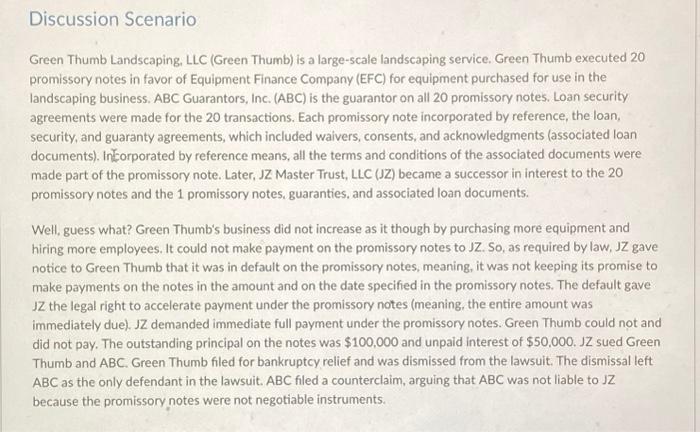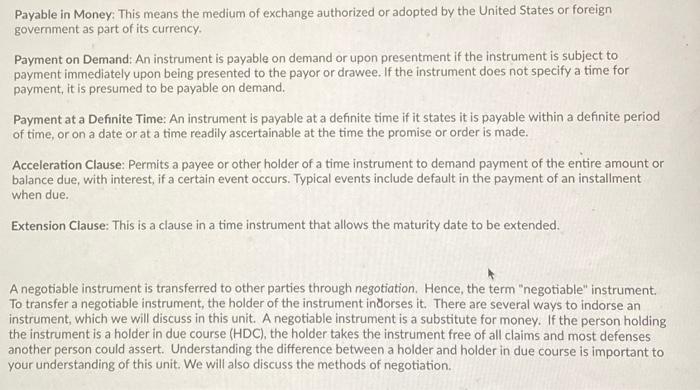Green Thumb Landscaping, LLC (Green Thumb) is a large-scale landscaping service. Green Thumb executed 20 promissory notes in favor of Equipment Finance Company (EFC) for equipment purchased for use in the landscaping business. ABC Guarantors, Inc. (ABC) is the guarantor on all 20 promissory notes. Loan security agreements were made for the 20 transactions. Each promissory note incorporated by reference, the loan, security, and guaranty agreements, which included waivers, consents, and acknowledgments (associated loan documents). In Corporated by reference means, all the terms and conditions of the associated documents were made part of the promissory note. Later, JZ Master Trust, LLC (JZ) became a successor in interest to the 20 promissory notes and the 1 promissory notes, guaranties, and associated loan documents. Well, guess what? Green Thumb's business did not increase as it though by purchasing more equipment and hiring more employees. It could not make payment on the promissory notes to JZ. So, as required by law, JZ gave notice to Green Thumb that it was in default on the promissory notes, meaning, it was not keeping its promise to make payments on the notes in the amount and on the date specified in the promissory notes. The default gave JZ the legal right to accelerate payment under the promissory notes (meaning, the entire amount was immediately due), JZ demanded immediate full payment under the promissory notes. Green Thumb could not and did not pay. The outstanding principal on the notes was $100,000 and unpaid interest of $50,000. JZ sued Green Thumb and ABC. Green Thumb filed for bankruptcy relief and was dismissed from the lawsuit. The dismissal left ABC as the only defendant in the lawsuit. ABC filed a counterclaim, arguing that ABC was not liable to JZ because the promissory notes were not negotiable instruments. Payable in Money: This means the medium of exchange authorized or adopted by the United States or foreign government as part of its currency. Payment on Demand: An instrument is payable on demand or upon presentment if the instrument is subject to payment immediately upon being presented to the payor or drawee. If the instrument does not specify a time for payment, it is presumed to be payable on demand. Payment at a Definite Time: An instrument is payable at a definite time if it states it is payable within a definite period of time, or on a date or at a time readily ascertainable at the time the promise or order is made. Acceleration Clause: Permits a payee or other holder of a time instrument to demand payment of the entire amount or balance due, with interest, if a certain event occurs. Typical events include default in the payment of an installment when due. Extension Clause: This is a clause in a time instrument that allows the maturity date to be extended. A negotiable instrument is transferred to other parties through negotiation. Hence, the term "negotiable" instrument. To transfer a negotiable instrument, the holder of the instrument indorses it. There are several ways to indorse an instrument, which we will discuss in this unit. A negotiable instrument is a substitute for money. If the person holding the instrument is a holder in due course (HDC), the holder takes the instrument free of all claims and most defenses another person could assert. Understanding the difference between a holder and holder in due course is important to your understanding of this unit. We will also discuss the methods of negotiation. Think about a promissory note you may have executed or that you may execute in the future. What did you learn from this week's learning materials that helped you better understand your legal rights and obligations? If you have not yet executed a promissory note, discuss one you may execute in the future. A negotiable instrument is not money; it is a substitute for money. Money freely transfers hands all the time. When you use cash to purchase a soft drink or cup of coffee, you deliver cash in exchange for the drink. The restaurant delivers the case to a bank for deposit. Merchants and consumers don't always carry cash. We worry about losing money or someone taking our money, unlawfully. A document must meet specific requirements to be a negotiable instrument. These requirements are established by Article 3 of the UCC. Article 3 governs a party's right to payment of a check, draft, note, or certificate deposit. Article 3 defines a negotiable instrument: A written instrument signed by the maker or drawer of the instrument that contains an unconditional promise or order to pay an exact sum of money (with or without interest in a specified amount or at a specified rate) on demand or at an exact future time to a specific person or to order or to its bearer. To be negotiable, the instrument must be signed by the maker (drawer). The signature is referred to as an "indorsement," which we will discuss more in this unit. The signature can be any symbol made by the maker as long as the maker intend the symbol to be his or her signature. It is important to know whether an instrument is a negotiable instrument. If the specific requirements for a negotiable instrument are not met, a person who receives a negotiable instrument (referred to as the "holder"), will not qualify as a holder in due course (HDC). Problems occur when a holder learns about a defense to payment, or the holder learns someone else has a prior claim to the instrument. For this reason, it is very important to understand the difference between an "ordinary holder" and a HDC. A holder wants to be a HDC. This will become clearer in a few minutes. A negotiable instrument can be used to extend credit from one party to another. For example, a bank lends money to pay for goods or services. A credit card company sells goods on credit. Merchants require consumers to sign a note promising to repay the money. If you have a credit eard account for $1,000, you do not have $1,000 in cash. You have a credit card that can be used as a substitute for up to $1,000 cash. A negotiable instrument can be a record-keeping device. For example, a cancelled check is a record. Today, most records are digital and are recorded electronically. Incorporating the learning materials from this week, discuss why JZ needs the court to find that the 20 promissory notes are negotiable instruments. To receive the maximum points for this part of the assignment, discuss what you learned about law that defines and applies to promissory notes, and the law that defines and applies to a negotiable instrument. Make sure to discuss whether JZ can enforce the promissory notes against ABC. There are four kinds of instruments: draft, check, promissory note, certificate of deposit. A draft is a three-party instrument. This means three persons are involved in the transaction. A draft is an unconditional written order by one party (drawer) that orders a second party (drawee) to pay money to a third party (payee). The drawer orders the drawee to pay money to a payee. Review the diagram on page 5 of the textbook. A check is an order made by a drawer to a drawee to pay a payee. To understand this, think about your personal check. You own the checking account, so you are the drawer. Your bank holds the funds in your checking account. The bank is the drawee. You write a check to the MCC Bookstore for a textbook. The bookstore is the payee. So, you the drawer order the bank drawee to pay the MCC bookstore payee. A promissory note is an unconditional written promise by one party to pay someone. The party making the promise is the maker of the note, also referred to as the borrower. The maker promise to pay the lender (payee) according to the terms of the promissory note. A promissory note is a negotiable instrument the payee can transfer to other parties. A promissory can be a time note, which means the instrument is payable at a specific time. Or, it can be a demand note, Which means the note is payable upon demand. Notes can be made payable to a "named" payee or simply to "bearer:" Understand, bearer means the person holding the note. A promissory note is a two-party instrument, not an order to pay. A Certificate of Deposit is created when an individual deposits money at a financial institution in exchange for the institution's promise to pay back the amount at specified time and agreed rate of interest. In this type of negotiable instrument, the borrowing bank is the maker of the note. The party depositing the money is the payee. A certificate of deposit is a two-party instrument. It is a promise to pay, not an order to pay. Important Terms for Negotiable Instruments Review of the following terms will help you understand the learning materials in this module. Promise or Order: A negotiable instrument must contain an express promise or an order to pay. The exception is the Certificate of Deposit. Unconditional Promise or Order. There must be an unconditional promise or order to pay to be a negotiable instrument. If the instrument states the promise or order is subject to or governed by another writing, or the rights or obligations regarding the promise or order are stated in another writing. Fixed amount of money: Negotiable instruments must state a fixed sum of money. Fixed sum means an amount that can be determined by looking at the face of the instrument. This applies only to the principal amount of money. The instrument can reference an outside source to determine the interest rate (e.g., a state statute, commercial index, etc.)












